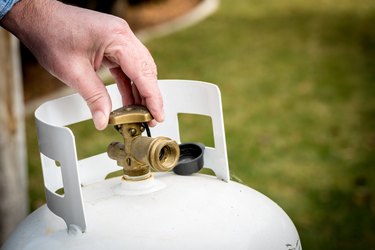Whether you use propane for heating or cooking, you need a regulator on your tank to ensure steady gas pressure at the point of use. This is an important safety issue because surges of high-pressure gas can cause flame bursts that could create fires in enclosed spaces. It's also important for the operation of propane appliances, particularly hot water heaters, which can switch off if the flow of gas becomes erratic. Regulators contain moving parts, which means they do wear out, and you have to replace them periodically. It's safe to do this yourself if you have a small tank that supplies a single appliance.

Video of the Day
Where Do You Find the Regulator?
All tanks have a shut-off valve on the top, and once you've found it, you've found the regulator. It's typically connected directly to the shut-off valve. It's usually gray, and its oval or round shape is slightly reminiscent of the starship Enterprise. The gas supply hose extends from the end of the regulator that isn't connected to the tank to its point of connection to the grill or appliance that uses the gas. This hose is usually permanently connected to the regulator, and you have to replace it when you replace the regulator.
Video of the Day
Any home that uses propane (called liquid propane or LP gas in the trade) has a tank somewhere on the property because, unlike natural gas, public utilities companies don't supply propane. If you have a large tank that holds hundreds of gallons of LP gas, it's best to have the regulator replaced by a pro, because getting the system leak-free after replacement is critical. However, it's safe to service your own 50-gallon-or-less tank. This includes, of course, a small tank that supplies gas to your outdoor grill.
Procedure for Replacing the Regulator
Before disconnecting your regulator from the tank, be sure to shut off the valve by screwing the handle clockwise as far as it will go. Many regulators have a large plastic collar that you can unscrew by hand. Turn this collar counterclockwise to detach the regulator from the valve. If your regulator doesn't have a plastic collar, use slip-lock pliers or a wrench to turn the large nut that connects the regulator to the valve. Some of these nuts have reverse threads, which means you have to turn them clockwise to loosen them. If you're turning a nut counterclockwise, and it seems stuck, try turning it the other way. After making this disconnection, unscrew the other end of the supply hose from its point of connection to the appliance, using pliers or a wrench.
It's best to take the regulator and hose to the hardware store when purchasing a replacement. Regulators come with hoses of various lengths, and you want to make sure you buy one that's long enough.
To replace the regulator, reverse the procedure for removing it. Screw the hose onto the appliance fitting and tighten it down with the tool you used to remove it. Sealing tape usually isn't necessary, just clean the fitting with a rag before making the connection, and you should get a good seal. Screw the regulator itself to the tank valve and tighten it by hand or with a wrench or pliers.
Don't Forget to Test
Once you've made the connections, it's important to check for leaks. Make a soapy solution using dish soap and water and spray some on both connection nuts, then open the valve on the tank and look for bubbles. If you see any, shut off the valve and tighten the connection, then open the valve and check again. Keep retesting and tightening until you don't see any bubbles. At this point, it's safe to leave the valve open and begin using the gas.
If the connection to the appliance has worn out, you may need to remove the regulator hose and wrap sealing tape around the fitting to prevent breakage from over-tightening. Don't use regular white plumbing tape for this. When making gas connections, you need PTFE tape rated for use with gas. It's yellow, and you can find it at any hardware store.